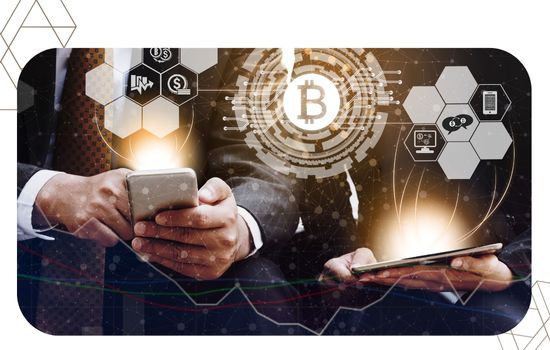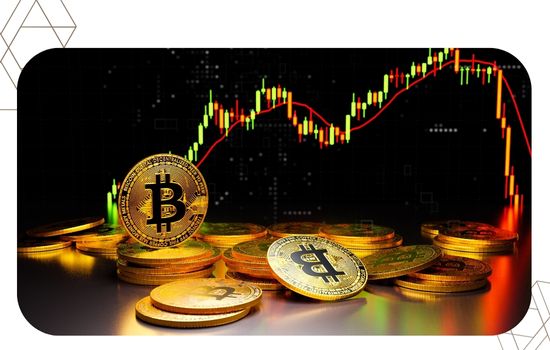Advertisements
It's clear from the start: Blockchain beyond cryptocurrencies: real-world applications It is not limited to the exchange of Bitcoin or Ethereum.

In 2025, its true value lies in concrete uses that transform industries and strengthen digital trust.
This article will cover its definition, relevance, main areas of application, two illustrative examples, a key statistic, an understandable analogy, and the challenges it faces in the future.
What is blockchain and why does it matter?
Blockchain is a decentralized, immutable, and shared digital ledger that allows multiple actors, without needing to blindly trust each other, to communicate, verify, or execute transactions transparently.
In this context, the phrase “beyond cryptocurrencies” It makes sense: it's about seeing its intrinsic value in areas ranging from food supply to energy infrastructure.
Advertisements
The reason this matters is twofold. First, it generates efficiency and reduces intermediaries in complex processes.
Second: it brings transparency and traceability where opacity and paperwork previously prevailed.
In 2025, research indicates that the tokenization of real-world assets (RWA) represents a paradigm shift.
For example, one academic study describes how tokenization can "increase liquidity and optimize the management of traditional assets" thanks to blockchain.
So why should you pay attention to Blockchain beyond cryptocurrencies: real-world applications ?
Because it's not a passing fad; it's an operational tool that has begun to be deployed in the real world.
Key areas of application
1. Supply chain and logistics
One of the clearest applications is in tracking products from their origin to the final consumer.
For example, Nestlé already uses blockchain so that parents can scan the code on their baby formula and see the ingredient's route.
Transparency leads to trust, but also to efficiency:
Imagine a piece of machinery that requires warranty tracking, piece by piece, with each step automatically recorded.
This technology makes it possible.
Original exampleA winery in Mendoza decides to register each barrel on a blockchain, recording data on harvest, weather, tasting, racking, and bottling.
When the wine is released to the market, any consumer scans a QR code and obtains a complete and unchanging history.
Result: premium price, lower risk of counterfeiting, and better inventory management.
2. Digital identity and e-government
The problem of digital identity is critical. Data breaches, fraud, and document duplication prove it.
Blockchain allows a person to control their own data, authorize its use on a case-by-case basis, and maintain a record of access.
According to a 2025 report, countries like Estonia and Singapore already have blockchain-based identity systems used for voting, health, and administrative procedures.
Original exampleA Mexican citizen uses his digital identity on the blockchain to obtain a driver's license, then consults his medical history, and a year later digitally signs a lease agreement.
Everything without printing paper, everything with permission controlled by him, verified and auditable.
3. Asset tokenization and alternative finance
Here the phrase "beyond cryptocurrencies" takes on its greatest meaning.
It is no longer about buying tokens as speculation, but about converting real assets such as real estate, machinery, energy, and art into digital fractions that can be traded or used programmatically.
An article indicates that the tokenization of real assets is unleashing a change in institutional financial markets.
Relevant statistics:
According to a 2025 study, more than 50 000 Insurance claims were automatically settled through smart contracts on the Etherisc platform in the first quarter of 2025.
The analogy here is helpful: imagine a toll highway where every (active) vehicle is automatically detected, paid, and logged.
Blockchain would be the digital toll system that manages the flow without centralized human intervention.
How it manifests in practice
To understand the scope of ** Blockchain beyond cryptocurrencies: real-world applications Let's review some concrete examples:
- In the health sector, drug custody chains now use blockchain to prevent counterfeiting.
- In energy, peer-to-peer trading platforms allow consumers to sell their surplus to neighbors, all under immutable records.
- In voting or open government, systems are being explored where votes are recorded without the possibility of alteration, increasing citizen trust.
These applications are no longer distant promises: they are real implementations, executed with operational technology, not just academic prototypes.
Key challenges and considerations
However, it's not all smooth sailing. Technology faces real challenges that you should be aware of.
First, scalability: many blockchain networks still do not handle massive transaction volumes without high cost or significant latency.
A 2025 study sums it up: “tokenization of real assets is held back by the simultaneous need for scalability, security and decentralized governance.”
Second, regulation and the legal framework: when tangible assets are digitized, the question arises of what the jurisdiction is, how ownership is enforced, and what happens in case of conflict.
Without a clear regulatory environment, adoption slows down.
Third, integration with traditional systems: implementing blockchain alone is not enough.
It must be coordinated with ERP, legacy databases, human processes, and audits.
If not done carefully, it can create the paradox of "blockchain on top of paperwork".
So, what can you do as a professional or company?
First, identify critical processes where there are multiple parties that do not fully trust each other.
Second, calculate the value of adding traceability, transparency, or automation and compare it with the implementation costs.
Third, start with pilot controlled, then climb.
Read more: Advantages and disadvantages of the metaverse in 2025
Why adopt Blockchain beyond cryptocurrencies: real-world applications now?
Because the technological and business environment is already demanding it.
The costs of not adapting can be just as real as those of adapting: fraud, non-compliance, loss of trust, slow processes, lagging companies.
Furthermore, competitors are already investing.
Early adoption offers a strategic advantage: a reputation for innovation, better efficiency metrics, and new business models (e.g., renting tokenized assets, secondary markets for fractional shares).
It also allows alignment with regulatory trends that favor greater transparency and traceability.
In short: blockchain is not just a “token” or a fad.
It is a transformation activator capable of redefining how digital trust works, how logistics are organized, and how the economy is financed.
Conclusion
The ** Blockchain beyond cryptocurrencies: real-world applications It is a serious proposal, increasingly mature, and with tangible potential.
We have seen its impact on supply chain, digital identity, asset tokenization, and more.
We also analyzed its challenges, and why now is the time to pay attention to it.
If you're still wondering "is it worth investing in or adopting this technology?", the answer is yes, as long as there is clarity about the problem to be solved, a willingness to change processes, and a long-term vision.
Blockchain is already here: not just as a token container, but as a digital trust infrastructure.
You are invited to be part of that change.

Read more: History of the first video games
Frequently Asked Questions
Is blockchain only useful for cryptocurrencies?
No. Although initially associated with digital currencies, today its applications go far beyond that:
Identity registration, product traceability, tokenization of physical assets, contract automation (smart contracts), among others.
Which sectors stand to benefit the most?
Sectors with multiple intermediaries, lack of transparency, or high risk of fraud:
Logistics, health, energy, real estate, government, and financial services.
Is blockchain technology secure today?
Yes, to a large extent. But it depends on the design: the network, consensus, off-chain storage, and governance all matter.
It is important to understand that blockchain does not eliminate all risks (e.g., bad actors, vulnerabilities in smart contracts) but it does reduce many associated with the traditional centralized system.
How much does it cost to implement it?
The cost varies depending on scope, number of participants, integration with existing systems, and level of customization.
A prudent approach consists of a low-risk pilot and gradual scaling.
Can I start on my own as an individual or small business?
Yes. There are low-cost platforms that allow you to explore blockchain without massive proprietary infrastructure.
Creating a transaction log, authenticating documents, or tokenizing a small asset can be good starting points.